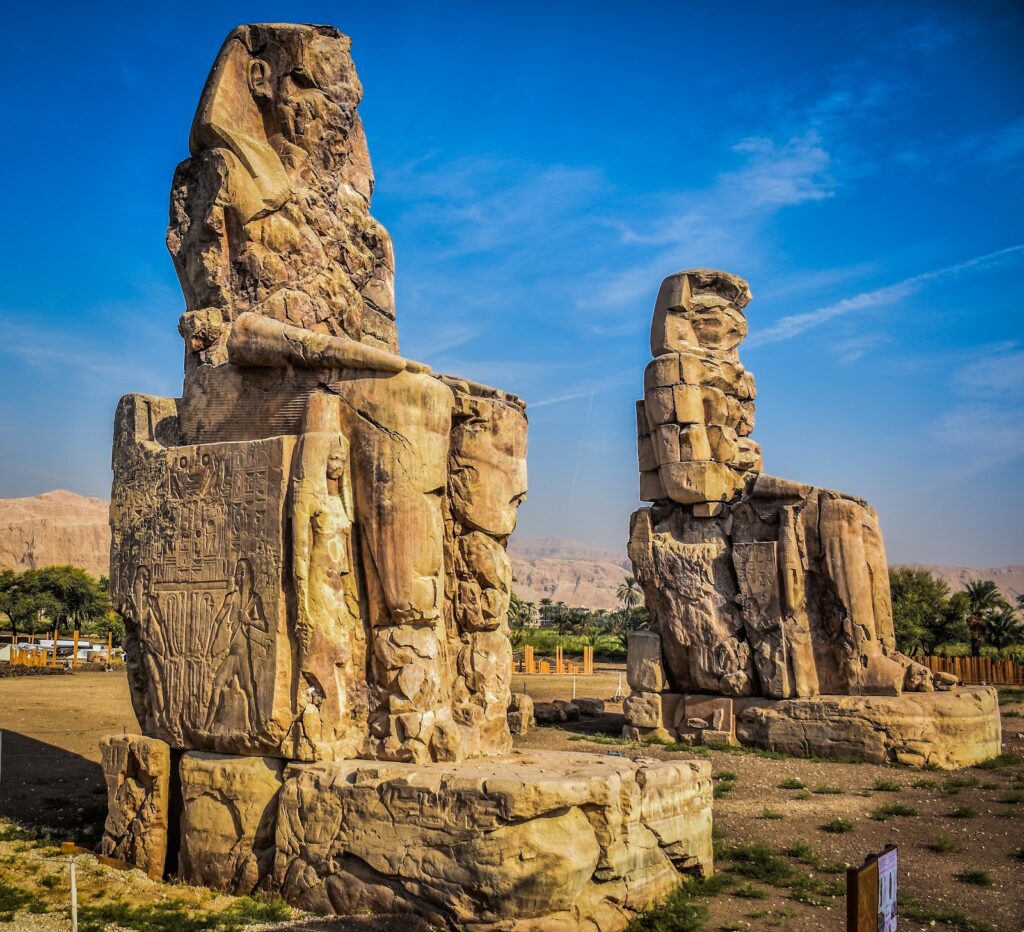The Grateful Statue: A Story of Art, Emotion, and Legacy2025
Introduction – The Timeless Power of Ancient Art
Emotion and Symbolism in Sculptural Form
Why This Statue Still Inspires Visitors Today
Ma statue est reconnaissante

Vestiges du temple funéraire du roi Amenhotep III, sans doute l'un des plus magnifiques et des plus grands temples funéraires jamais construits. Les deux statues géantes du roi Amenhotep III en témoignent. Il semble que le temple ait été détruit par les rois suivants ; il n'en reste que des fragments de ses fondations et une stèle funéraire.
The statue
The statue is large, about 10 meters long, and two massive statues called “My Statue” once adorned the front facade of the temple before the main building. The name Memnon given to it during the Greek period, attributed to the Trojan hero, son of Eros.
Les deux statues représentent le roi Amenhotep III et mesurent environ 21 mètres de haut. Elles ont été taillées dans un seul bloc de pierre. La statue nord s'est brisée lors d'un violent tremblement de terre en 27 av. J.-C., produisant, sous l'effet du vent, un son aigu. Ce phénomène est devenu connu sous le nom de « Chant de Memnon ». L'empereur romain Hadrien et son épouse se sont rendus sur place pour admirer et entendre cette merveille. Sous l'empereur Septime Sévère, les fissures de cette statue ont été comblées, et elle a cessé de chanter.
The Story Behind the Grateful Statue
Historical Background and Cultural Significance
Myths, Legends, and Local Interpretations
The Colossi of Memnon
The Colossi of Memnon stand as eternal sentinels on the west bank of the Nile near Luxor, echoing the grandeur of ancient Thebes. These two massive statues, each rising over 18 meters high, once flanked the entrance of the grand mortuary temple of Pharaoh Amenhotep III. Carved from quartzite sandstone, the statues depict the seated pharaoh, hands resting on his knees, facing east toward the rising sun. Though the temple behind them has largely disappeared over the millennia—due to floods, earthquakes, and the repurposing of its stone—the legacy of the statues endures as a testament to Egypt’s architectural and artistic mastery. They became a symbol not only of divine kingship but also of enduring cultural heritage. During the Greco-Roman period, the northern statue famously “sang” at dawn—emitting a mysterious sound believed to be the voice of Memnon, a hero of the Trojan War, which led to their renaming. This phenomenon attracted pilgrims, poets, and emperors, making the site a blend of Egyptian spirituality and classical mythology.
The Legacy of the Monument in 2025
Restoration Efforts and Preservation Projects
Its Influence on Modern Art and Tourism
The importance of the temple (The Grateful Statue)
The importance of the temple these statues once guarded cannot be overstated. Built in the 14th century BCE during the reign of Amenhotep III, the temple was among the largest and most magnificent in Egypt’s New Kingdom. It served as a mortuary temple (The Grateful Statue) where priests conducted rituals to honor the pharaoh’s divine essence and ensure his eternal presence in the afterlife. The temple complex included a vast array of columns, courtyards, sanctuaries, and smaller statues, all richly adorned with reliefs celebrating the king’s achievements and his connection to the gods. Its location on the west bank—associated with death and rebirth—was strategically chosen to align with ancient religious beliefs. Although much of the temple has been lost, recent excavations have uncovered statues, sphinxes, and inscriptions that shed light on its former splendor. Today, the site(The Grateful Statue) remains a powerful reminder of Egypt’s spiritual and political history.
Conclusion – A Monument of Memory and Meaning
Reflecting on the Past Through Artistic Expression
Why the Grateful Statue Continues to Matter Today
Visiting the Colossi of Memnon
Visiting the Colossi of Memnon and their surroundings is like stepping into a forgotten world where myth, memory, and monumental craftsmanship converge. These remnants continue to inspire awe, providing insight into the beliefs and legacy of one of ancient Egypt’s most influential rulers.
Les statues représentent le roi, les mains posées sur les genoux, regardant vers l'est, en direction du Nil. Chaque statue repose sur un immense socle en granit représentant le trône, et de chaque côté du trône, à ses pieds, se trouvent des gravures interprétées comme des symboles du monothéisme. Le roi est accompagné de statues plus petites représentant la grande épouse royale Tiy et sa mère. La mission allemande a récemment restauré ces deux statues, des traces de peinture d'origine y ayant été retrouvées.
Excursions populaires à Hurghada

